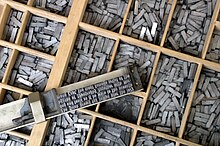Robert Smail's Printing Works

Robert Smail's Printing Works is a fully functional
History
The firm was established in 1866, carrying out print jobs for the local community as well as operating a stationer's shop, and between 1893 and 1916 published a weekly newspaper. It remained in the ownership of the Smail family, who made little effort to keep up with twentieth-century advances in technology, and, through an initiative from Innerleithen Community Council, led by Iain Henderson and Nettie Watson, was run by the third-generation owner Cowan Smail until he retired and the property was acquired by the National Trust for Scotland in 1986 and opened to the public in 1990.[1] Visitors are given a one-hour tour showing the various stages of the process as well as a chance to try hand typesetting, and at certain times the opportunity to print their own work. The building is protected as a category C(s) listed building.[2]
The Printing Works

The ground floor of a two-storey building on the main shopping street of the town is divided into a shop, now a
Paper store and caseroom

A door leads out the back to the paper store, a large room now housing an archive of nearly every printed job for a century. At one end the undershot water wheel which originally powered the works has been reconstructed.

Stairs lead up to the caseroom, a large rooflet room for
Machineroom

The machineroom is also rooflet, and the printing presses include a hand-fed pedal-operated platen press, a large belt-driven Wharfedale Reliance print machine bought in the 1870s which was originally powered by belt drive from the water wheel, and an automated Heidelberg Platen bought in 1952. A printer demonstrates the operation of these machines to the visitors.
Events
Robert Smail's Printing Works has printing workshops in the winter, and participates in events such as the Innerleithen Honey Festival at St Ronan's Wells. In September 2007 "living history tours" were introduced on the occasion of the celebrations of 500 years of printing in Scotland.
See also
The National Trust for Scotland has three further properties in the Scottish Borders:
- Priorwood Garden
- Harmony Garden
- St Abb's Head National Nature Reserve
- List of places in the Scottish Borders
- Damside
References
- Sources
- Come & Visit, pamphlet printed at Robert Smail's Printing Works, 2007.
- Property Page for Robert Smail's Printing Works, The National Trust for Scotland Retrieved 2007-05-08
- Robert Smail's Printing Works, Information on Scotland.com Retrieved 2007-05-08
- 2008: Year of the Printed Word: 500 years of printing in Scotland Retrieved 2007-05-08
- Notes
- ^ Rudram, David. "Robert Smail's Printing Works", Ancestors, November 2008, pp 54-55.
- ^ Historic Environment Scotland. "5, 7, 9 and 11 High Street, Robert Smail's Printing Works, including Printing Works, Courtyard and Mill Lade (Category C Listed Building) (LB51077)". Retrieved 22 March 2019.
